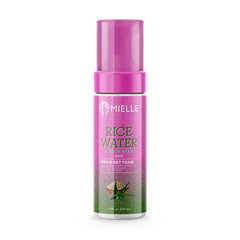What is Postpartum Hair Loss
Somewhere between three to six months after giving birth, a new mom will often experience a sudden shedding of hair. Sure, we shed hair daily, but this is different because it’s excessive, often coming out in clumps. But why?
Why Postpartum Shedding Happens
First of all, there’s no need to freak out if you find chunks of hair coming out on wash day a few months after giving birth. This is normal! Here’s the science behind what’s happening...
Each strand of hair on our heads is going through different stages of the hair cycle. The strands in the resting stage are the ones that make up the 100 or so hair strands that the average person sheds daily. Once the resting period is done, the hair falls out, and new hair comes in.
But, during pregnancy, estrogen levels increase and extend the hair stage! This is why a pregnant woman’s hair often looks so much fuller and lush than ever. These high levels of estrogen are also responsible for that infamous “glow” we have during pregnancy. Because the hair stage is prolonged, there’s less hair “resting” and you manage to hang on to more hair while you’re pregnant.
But don’t get too attached. Normally, once a woman gives birth and those hormone levels take a dive, so does all that “extra” hair! It may be a bit scary at first and you may wonder if you’re gonna be bald (I speak from experience) but this is just your body getting back to normal.
What Can You Do About It?
According to the experts, within a year of giving birth, everything should level off and postpartum hair shedding should be done. Breastfeeding can help slow down the shedding but, for the most part, you just have to let nature run its course.
While you can’t stop the shedding from happening, you can make sure you don’t lose any more hair than you have to! A dietary supplement, like our Healthy Hair Formula, along with a healthy, balanced diet will help promote healthy hair as you deal with postpartum shedding. Regular scalp massages with our Mint Almond Oil can help stimulate the hair follicles to encourage healthy hair.
Try out different styles that will help camouflage any loss you may have experienced and not make the situation worse. For example, instead of pulling your hair back so often, opt for styles that include a bang or a loosely placed roll, tuck and pin faux bang to reduce stress around the edges and the temple area, which is usually the most affected.
Since caring for a newborn takes a lot of time, you may even consider a big chop to make life easier. Hey, one less thing to worry about and the hair loss is less noticeable.
It’s also a good idea to give heat styling and chemicals (like hair color) a break until your hair catches up with itself to be on the safe side. If you do occasionally decide to use heat, our Mongongo Oil Thermal & Heat Protectant Spray will help keep breakage and further loss at bay. Remember, you can’t stop postpartum shedding but you can work on keeping as much hair on your head as possible!
What was YOUR experience with postpartum hair loss? How did you get through it?
Resources: What to Expect, BabyCenter

















